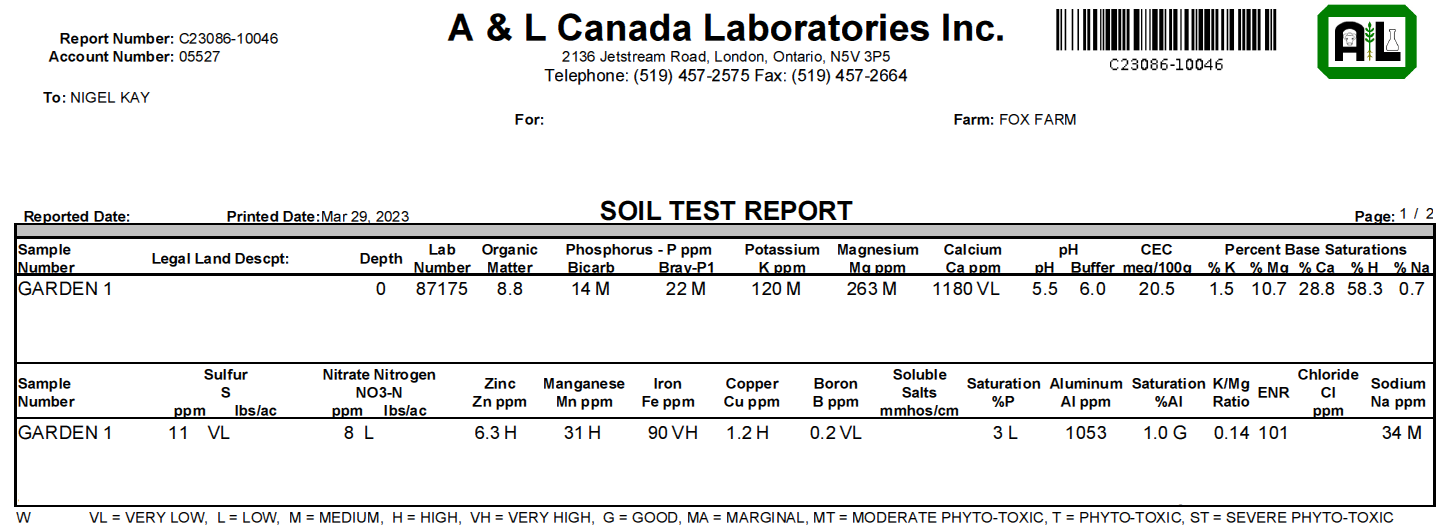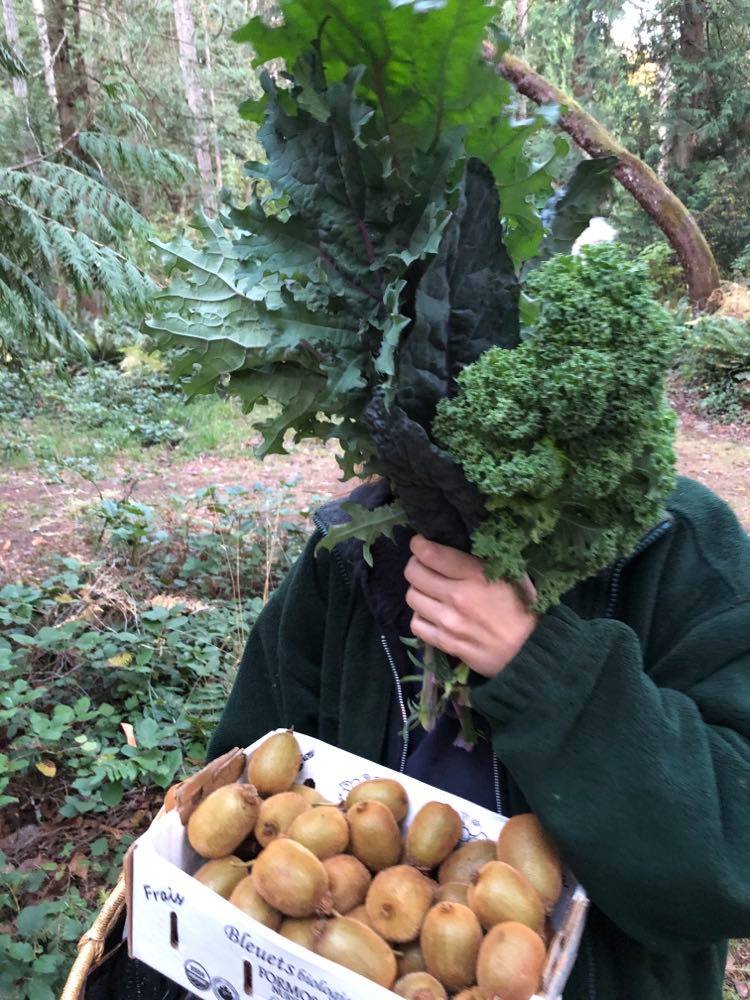From Hungry Soil to Nutrient Dense Kale

Disclaimer: This content is for educational purposes only and reflects the soil management approach we use on our own farm and teach in our workshops. It is not professional agronomic advice, a fertilizer recommendation, or a prescription for your operation. Always obtain independent soil tests and consult a qualified local agronomist or certified crop advisor before making fertility decisions. We accept no liability for any outcomes resulting from the application of ideas discussed here.
Take a look at the soil test. List the ppm of the elements provided, plus the relevant ratios.
Here is a clear summary of your GARDEN 1 soil test (A&L Canada, Mehlich-3 extractant) for the Pacific Northwest context:
Macronutrients & Key Values (ppm)
- Phosphorus (P): 22 ppm (Bray-P1 equivalent shown, rated Medium)
- Potassium (K): 120 ppm (Medium)
- Magnesium (Mg): 263 ppm (Medium)
- Calcium (Ca): 1,180 ppm (Very Low for our region)
- Sulfur (S): 11 ppm (Very Low)
- Nitrate-N (NO3-N): 8 ppm (Low)
- Zinc (Zn): 6.3 ppm (High)
- Manganese (Mn): 31 ppm (High)
- Iron (Fe): 90 ppm (Very High)
- Copper (Cu): 1.2 ppm (High)
- Boron (B): 0.2 ppm (Very Low)
- Aluminum (Al): 1,053 ppm (extremely high – toxic range)
- Sodium (Na): 34 ppm (Medium)
Soil Properties
- Organic Matter: 8.8 % (excellent)
- pH: 5.5 (Buffer pH 6.0)
- CEC: 20.5 meq/100 g (very good for a mineral soil)
Base Saturation (%)
- Calcium: 28.8 % (extremely low – ideal 65–75 % in PNW)
- Magnesium: 10.7 % (low – ideal 12–18 %)
- Potassium: 1.5 % (very low – ideal 3–7 %)
- Sodium: 0.7 %
- Hydrogen: 58.3 % (far too high – reflects acidity)
Key Ratios (Albrecht-style)
- Ca : Mg = 2.7 : 1 (poor – ideally 6–8 : 1 in western Oregon/Washington mineral soils)
- Ca : K = 19 : 1 (poor – ideally 10–15 : 1)
- Mg : K = 7 : 1 (acceptable, but both bases are too low absolutely)
- Ca base saturation : 28.8 % (critically deficient)
- Mg base saturation : 10.7 % (deficient)
- Excess Aluminum saturation : ~1.0 % (toxic – drives pH down and blocks Ca/Mg uptake)
Quick PNW Interpretation (Solomon/Albrecht lens)
Your soil is a classic “acid, aluminum-toxic, calcium-starved” profile common west of the Cascades on older gardens or cleared forest land. High organic matter is a big plus, but the very low calcium saturation (28.8 %) and high soluble aluminum (1,053 ppm) are the primary limiting factors right now. Boron and sulfur are also seriously deficient. Potassium is low, magnesium is marginal, and most micros (except Mn, Fe, Zn) are adequate to high.
Major corrective actions needed:
- Heavy limestone (calcitic or dolomitic) application to raise Ca base saturation toward 68–70 % and detoxify aluminum.
- Gypsum (calcium sulfate) to supply soluble Ca and S without raising pH further until limestone catches up.
- Boron (Solubor or borax) – critical and very low.
- Modest potassium and magnesium adjustments once Ca is on track.
Fox Farm Garden 1 – Kale Soil Rebalance (100 sq ft Bed)
Mehlich-3 • November 18, 2025
Current Macronutrients & Key Elements (ppm)
- Phosphorus (P): 22 ppm (Medium)
- Potassium (K): 120 ppm (Medium)
- Magnesium (Mg): 263 ppm (Medium)
- Calcium (Ca): 1,180 ppm (Very Low – critically deficient)
- Sulfur (S): 11 ppm (Very Low)
- Boron (B): 0.2 ppm (Very Low)
- Soluble Aluminum: 1,053 ppm (Toxic)
- Nitrate-N: 8 ppm (Low)
Current Base Saturations vs. Kale Ideal (PNW Albrecht)
| Base | Current % | Ideal % | Status |
|---|---|---|---|
| Calcium | 28.8% | 70% | Critically low |
| Magnesium | 10.7% | 15% | Low |
| Potassium | 1.5% | 5% | Very low |
| Sodium | 0.7% | <2% | Acceptable |
| Hydrogen | 58.3% | <10% | Far too high |
Current Ratios: Ca:Mg 2.7:1 | Ca:K 19:1 | Mg:K 7:1
(All badly out of balance – classic acid, Al-toxic PNW soil)
Target Ratios for Kale
Ca:Mg ≈ 4.7:1 | Ca:K ≈ 14:1 | Mg:K ≈ 3:1
pH 6.4–6.6 | Al < 350 ppm | B 1.2–1.5 ppm
Fertilizer Recipe – Apply NOW (per 100 sq ft)
- Calcitic lime: 6.5 cups
- Gypsum (pelletized): 4 cups
- Dolomite lime: 1 heaping cup
- Sulfate of potash (0-0-50): 1.5 cups
- Solubor (20.5% B): 3 level tsp (12 g)
- Alfalfa meal: 8 cups
- Feather meal: 2 cups
- Fish meal/fish bone meal: 2 cups
- Kelp meal: 4 cups
- Azomite/basalt rock dust: 2 cups
Broadcast, rake into top 6–8″, mulch heavily with leaves/compost.
Projected Fall 2026 (after winter reaction)
| Element/Base | New ppm / % | New Ratio |
|---|---|---|
| Calcium (Ca) | ≈2,900 ppm / 70% | |
| Magnesium (Mg) | ≈370 ppm / 15% | Ca:Mg ≈ 4.7:1 |
| Potassium (K) | ≈400 ppm / 5% | Ca:K ≈ 14:1 |
| Sulfur (S) | 55–65 ppm | |
| Boron (B) | ≈1.4 ppm | |
| Soluble Aluminum | < 350 ppm | |
| pH | 6.4–6.6 |
Result: Balanced, aluminum-detoxified soil ready for dark-green, high-yielding, disease-resistant kale in 2026. Re-test next fall – only light maintenance needed thereafter.
IF I wanted to do a similar fertility program with PERMACULTURE using all natural resources, what would it look like?
Fox Farm Garden 1 – Natural Kale Rebalance
(100 sq ft • November 2025 • PNW closed-loop)
| Material | Amount per 100 sq ft | Approx. wet/dry weight |
|---|---|---|
| Composted cow/horse manure | 6–8 heaping 5-gal buckets | 180–240 lb |
| Fresh beach seaweed (wet) | 5–6 heaping 5-gal buckets | 200–250 lb |
| Raw animal bones (whole) | 12–15 lb (scatter) | 12–15 lb |
| Clean hardwood fire ash | 8–10 cups sifted | 3–4 lb |
| Shredded maple leaves | 4–5 full 95-gal garbage bins (loose) | 250–350 lb |
Application: Rake manure + seaweed into top 6–8″ → scatter bones + ash → blanket with leaves (8–12″ deep, settles to 3–4″).
Estimated Elements Added (total per 100 sq ft)
- Nitrogen (N) 0.50–0.65 lb (slow organic)
- Phosphorus (P₂O₅) 0.25–0.35 lb
- Potash (K₂O) 0.35–0.45 lb
- Calcium (Ca) 2.4–2.8 lb
- Magnesium (Mg) 0.15–0.20 lb
- Sulfur (S) 0.6–0.8 lb
- Boron + traces oceanic package from seaweed












